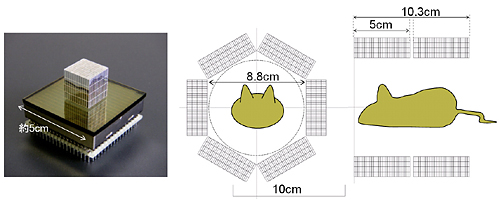NIRS NEWS No.106, SEP 2005
A Conceptual Design of jPET-RD, a next-generation small animal PET scanner
Taiga Yamaya
The PET spatial resolution of 1mm can be achieved when each voxel of 1 mm x 1 mm x 1 mm has enough S/N over the whole filed of view. If the sensitivity of a scanner remains the same, the smaller voxel obtains the smaller number of counts and its S/N is reduced. Therefore, a high sensitivity using small scintillation crystal is required.

|
|---|
We employed an LYSO scintillator crystal whose dimension is 1.4 mm x 1.4 mm x 4.5 mm, and a four-layer DOI block consist of 32 crystals x 32 crystals x 4 crystals was developed, as shown in the left of the first figure. The total thickness is 18 mm. Each element crystal could be identified when the block was uniformly irradiated by a 22Na point source.
According to our simulation, a small PET scanner consists of 12 DOI detector blocks mentioned above possesses 1.0 to 1.5 mm spatial resolution, while conventional (foreign) ones have those of 2.0 mm (at the center of FOV) to 6.0 (at the edge of FOV) mm. Farther more, the DOI block of six-layer or eight-layer possesses the better spatial resolution at distant positions from the center of FOV, as shown in the right of the second figure.

|
|---|
In near future, the coincidence measurements will be demonstrated by using one pair of the four-layer DOI blocks.